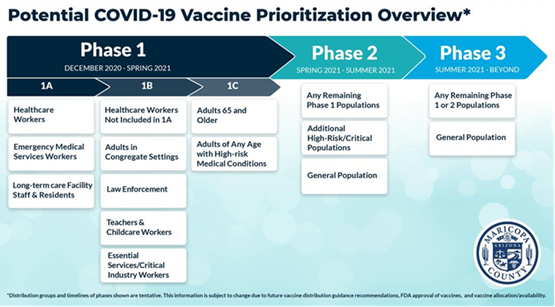The Monday Morning Quarterback
A quick analysis of important economic data released over the last week
I have a few miscellaneous pieces of information to pass along this week.
- The first is a chart showing the order in which COVID-19 vaccinations will be given in Maricopa county (see chart below). The order is broken into three phases. And phase 1 is broken into three groups. It will tell you where you stand and approximately when it will be your turn.
- The second is a site put up by the New York Times that predicts where you are in the queue to get the vaccine shot. It tells you approximately how many people are ahead of you. https://www.nytimes.com/interactive/2020/12/03/opinion/covid-19-vaccine-timeline.html
- The third is an honor that goes to California Governor Gavin Newsom. Perhaps the honor should be accompanied by a book in basic economics. U-Haul, like hotels and airlines, prices based on supply and demand, i.e., how many people want to go to an area versus how many people want to leave that area. So, if lots of people want a truck to move their possessions from, say, San Francisco to Phoenix and few people are going the other way, the price of the truck will be higher on the San Francisco-Phoenix trip than on the Phoenix-San Francisco trip. How badly do people want to leave San Francisco and move to Phoenix? Based on the U-Haul web site, if you want to rent a 10’ truck to make that trip, the cost would be $1,188. That’s five times more than the cost of renting the same truck from Phoenix to San Francisco. The multiple of the price goes up with longer trucks. It costs eight times more to rent a 26’ truck from the Bay area to Phoenix than it does to rent it from Phoenix-S.F. What that tells you is that there are a lot more people moving in this direction from San Francisco than the other way around. The prices are slightly different from Los Angeles to Phoenix and the other way around. But, the important thing is that multiple of how much more it costs to move from L.A. to Phoenix is about the same as it is in moving from San Francisco. This is what happens when bad public policy helps turn two of America’s great cities into places people want to flee. The only negative from my standpoint is while the net number of former California residents who became so disillusioned with the mess in California that they voted with their feet, is that many have brought the political views that created the same mess with them. Thus, Prop. 208 passes.
- The fourth is to remind you that the current economic outlook in the U.S. is driven by a non-economic issue: the Coronavirus. Thus, what has happened since mid-March has little to do with economic policy. Estimates are that GDP for 2020 will decline by 3.5%. This would be the largest annual decline in real GDP since the 11.6% decline in 1946. And remember, the 1946 decline was due to the end of World War II. So, it was also non-economic or at least not a normal cycle. By comparison, during the Great Recession, the largest decline (2009) was 2.5%. The recovery can be aided, though, by some good policy out of Congress. Given how long it has taken to get more relief to those who need it (as opposed to those who don’t) and for the two major parties to come up with a reasonable compromise on aid to cities and states and control liability issues for schools, businesses and government entities, it would be a pleasant surprise if what Congress comes up with is not a mess.
- The fifth has to do with consumer confidence. The December University of Michigan Consumer Sentiment Index was up. What is interesting, but perhaps not surprising, was that from August to December, the expectations part of the index rose 39.5 points among Democrats and fell by 34.9 points among Republicans. For those who identify as Independents, expectations remained rather flat.
As for last week’s data, initial claims for unemployment insurance went up a lot. This was worse than expected although I’m not sure it should have been given the number of areas that re-closed parts of their economies or even had lockdowns. The Blue Chip forecast calls for real GDP to rebound nicely in 2021. The number of job openings in the U.S. rose modestly. Consumer prices remained under control. And consumer credit remained a double-edged sword as credit card debt declined and non-revolving debt continued to rise.
In Arizona, initial claims also rose. Retail sales slowed for technical reasons. And the Tucson resale housing market saw a continuation of the imbalance between supply and demand. As a result, the median sales price of homes sold through the MLS was 20.8% higher than a year ago.
U.S. Snapshot:
- Initial claims for unemployment insurance increased to 853,000 for the week of December 6th. This was 137,000 claims higher than the previous week. This was much higher than expected. Perhaps it should not have been. Rising initial jobless claims indicates that more people are losing their jobs for the first time. Given the uptick in re-closures and lockdowns in the face of rising COVID-19 cases, this is not surprising. The increase in initial claims is likely to continue until the lockdowns and re-closures stop. Hopefully, this will occur soon. Last week’s number was 259.9% above a year ago. That compares to 247.6% the previous week.
- The Blue Chip consensus forecast is projecting that 2020 real GDP will decline by 3.5%. This would be the largest decline since 1946 and the largest decline for economic (cyclical) reasons since the Great Depression. Both 2020 and the large decline in 1946 we caused by non-economic (non-cyclical) reasons. This non-economic situation (COVID-19) means that estimating the numerical impact of the potential slowdown on the economy is more difficult than usual. The panel expects real GDP to be up by 4.0% in 2021. This would be considerably above the longer-term growth rate of 2.3%.
- The University of Michigan Consumer Sentiment index for early December rose to 81.4 from November’s 76.9. A year ago (pre-COVID) the index stood at 99.3.
- The CPI for all urban consumers rose by 0.2% in October. The index stood 1.2% above year earlier levels. Adjusted for food and energy, the index was still up 0.2% for the month but was up 1.7% from a year ago. This is still well below levels that would trigger any action by the FED.
- Consumer credit increased at a 2.1% annual rate in October and stood 0.3% higher than a year earlier. Revolving credit, though, declined at a 6.7% annual rate and stood 10.0% below its October 2019 level. Thus, not only have consumers been accumulating cash rapidly since COVID-19 became a major threat, but they have cleaned up their credit card debt. On the other hand, revolving credit (auto loans for example) rose at a 4.8% annual rate in October and stood 4.0% above a year ago.
Arizona Snapshot:
- Initial claims for unemployment insurance rose for the week of December 5th. Despite that, they stand 79.0% above a year ago. This compares to 120.4% for the previous week.
- The Greater Tucson MLS for November indicated that total listings were 1,220 compared to 2,513 the previous year. That’s a 51.5% decline at the same time when closed sales increased by 10.7% This imbalance in supply and demand resulted in the median sales price of a home sold in November to be 20.8% higher than it was a year earlier. This is obviously not sustainable.

About EDPCo
Elliott D. Pollack & Company (EDPCo) offers a broad range of economic and real estate consulting services backed by one of the most comprehensive databases found in the nation. This information makes it possible for the firm to conduct economic forecasting, develop economic impact studies and prepare demographic analyses and forecasts. Econometric modeling and economic development analysis and planning are also part of our capabilities. EDPCo staff includes professionals with backgrounds in economics, urban planning, financial analysis, real estate development and government. These professionals serve a broad client base of both public and private sector entities that range from school districts and utility companies to law firms and real estate developers.










